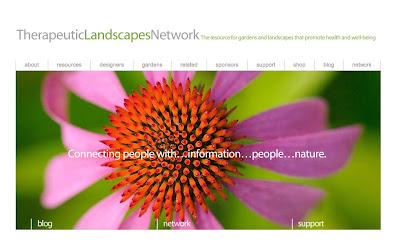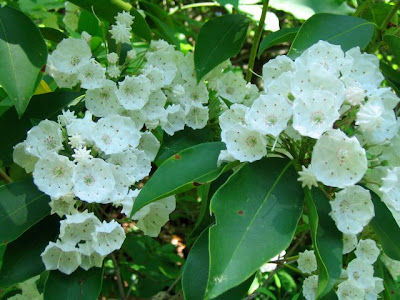On the the first day of the ASLA Conference in Chicago this year, I went on a Field Session where we toured three therapeutic gardens in three different locations. It was a great day, and I’ll be blogging more about that soon.
Healing Garden
Essential Design Elements for Therapeutic Gardens
September 28, 2009
Today’s Healing Garden: Sitting Quietly, Taking Nature In
September 25, 2009
Guest Blog Post by Shawna Coronado: Ball Horticulture Teaches Employees How To Tend To Nature and Their Health by Building a Community Garden
September 11, 2009

Almost there! Therapeutic Landscapes Network gears up to launch new website
- improved searchability and richer imagery;
- an expanded Designers and Consultants Directory;
- an expanded Directory of Therapeutic Gardens;
- sponsorship opportunities for businesses and organizations to promote their products, services, and expertise;
- an integrated blog (website and blog all under one virtual roof);
- an interactive Network Forum where members can meet and share information and ideas;
- and more information than ever before on gardens, landscapes, and other green spaces that facilitate health and well-being, for an even broader global community of designers, health and human service providers, educators, students, gardeners, and nature enthusiasts.
- Email us at info@healinglandscapes.org if you’d like to list in our Designers and Consultants Directory or be one of our fabulous sponsors.
- Sign up here (or with the form in the right-hand column – same thing, different look) to become a member and get on our mailing list. It’s free, and we’ll put you on our newsletter list so we can tell you right away when we launch the new site.
Edible Gardens are Healing Gardens
August 30, 2009
I can’t believe summer’s almost over. It flew by this year. Depending on where you are in this country, or in the world, your growing season is coming to a close (or just beginning, if you’re in the Southern Hemisphere – lucky you!). Here in the Hudson Valley, we’ve got a couple of months left before a hard frost hits, with end-of-the-summer treats like corn, tomatoes (though many fewer this year due to the blight), peppers, and melons. In my own tiny raised bed garden, I’ve got tomatoes, chard, arugula, and lots of herbs.
The High Line: A “Landscape for Health”
July 24, 2009





Mountain Laurel and Russel Wright
June 6, 2009
Scent as emotional memory trigger in the healing garden
May 14, 2009
Lilacs. Roses. Jasmine. Gardenia. Freshly mown grass. Chaparral. Depending on where you grew up, these scents probably conjure up some pretty powerful emotions and memories. In fact, of the five, our olfactory sense is the strongest emotional memory trigger. According to a June ’09 issue of Organic Gardening, “That’s because the part of our brain responsible for basic memory evolved out of the tissue that makes up the olfactory cortex.” For a slightly more detailed explanation, see this article on the psychology of scent, “Whisking up a memory with a whiff: Rachel Herz explores the psychology of scent.“) And here’s another good one, from Science & Tech: “Can you really smell memories? How childhood scents get ‘etched’ on the brain.” See also our next blog post, a guest post by Wendy Meyer that includes a link to her thesis “Persistence of Memory: Scent Gardens for Therapeutic Life Review in Communities for the Elderly.”
Fragrance in the healing garden
For this reason, using plants with fragrant flowers and foliage is an important part of designing the healing garden.* Especially in nursing homes, dementia gardens, and other landscapes for people with memory loss, scent can be very powerful. Consider this story, from Martha M. Tyson’s wonderful book The Healing Landscape: Therapeutic Outdoor Environments, about our colleague Vince Healy:
Vince’s grandmother was in her nineties. For quite some time she had not recognized Vince and was not really fully aware of what was going on around her. Since it was Easter time, Vince decided to pay her a visit. During his drive there, Vince came upon a roadside stand that advertised lilacs for sale. In southern California, lilacs do not grow well. This stand, however, had great quantities of them, and they were cheap. So Vince brought an enormous number of the lilacs and put them in the back of his van…By the time Vince arrived at the nursing home, the lilacs were looking very sad. When Vince walked into his grandmother’s room, she looked at him as always, blankly, and then she looked at the flowers. “They’re wilted! Throw them away!” After all this effort Vince was not about to throw them away, so he moved the lilacs closer, right under her nose. She drew in the fragrance with a deep breath and a sigh and said, “Lilacs….” Then she looked up at Vince and said, “Vinnie, how are you?”
Designing with fragrance as an emotional memory trigger
But even with less miraculous results, scents that elderly people remember fondly – “old-fashioned” flowers like lilacs, honeysuckle, gardenia, mock orange, roses – can evoke positive feelings and often facilitate conversations, thus providing something important but often lacking in places like nursing homes: Personal connection. Because our sense of smell often decreases as we age, strongly scented plants have a better chance of triggering a reaction than something subtle. I highly recommend Tyson’s book for more information, and Clare Cooper Marcus and Marni Barnes’ book Healing Gardens: Therapeutic Benefits and Design Recommendations is also valuable, especially the Chapter 8 on nursing home gardens and Chapter 9 on Alzheimer’s treatment gardens. Several other books have been published on gardens for the elderly, including Jack Carman et al’s new book Recreating Neighborhoods for Successful Aging. If you know of books that specifically address this issue of scent as a memory trigger in healing gardens, I’ll add it to our list!
*One caveat: In some cases, such as with gardens for cancer patients undergoing chemotherapy, even a good scent may be too overwhelming, and even nauseating. I don’t know of any specific research on what to steer clear of – if anyone reading this knows, please pass the information my way and I’ll list it on the Therapeutic Landscapes Network’s website.
Planting the Healing Garden: Medicinal Herbs
April 12, 2009
One of the most frequently-asked questions at the Therapeutic Landscapes Network is about what grows in a healing garden. Many people assume that a “therapeutic landscape” is a garden filled with herbs grown and harvested for their medicinal properties – in essence, that the healing comes from the plants in the garden. And this is certainly true some of the time (for a more thorough explanation about and definition of healing gardens, therapeutic landscapes, and landscapes for health, see this post and this post). More often, though, a healing garden is simply a garden filled with plants; research has shown that the more heavily planted a garden is, the more restorative it will be. The type of plant seems to be less important, though a variety of flora that stimulates the senses is a good start.
That said, many healing gardens contain at least some medicinal herbs, which are grown for a variety reasons: Their scent, or texture, or aesthetic qualities, or for their symbolism (for example, Topher Delaney designed the Carolyn S. Stolman Healing Garden at the Avon Foundation Breast Center in San Francisco, CA with plants that were traditionally used to treat cancer). Are they always harvested, processed, and used for salutary purposes? Nope. The fact is that especially in a healthcare setting, there often isn’t time or knowledge or the right equipment for, say, distilling Echinacea flowers into the tincture that you would use to boost the immune system. Are they beautiful, native, easy-to-maintain flowers that attract butterflies and symbolize health? Absolutely! Do they get harvested to ward off the common cold? Not usually.
The wonderful thing about herbs is their versatility. Lavender, for example, is easy to grow; drought tolerant; beautiful; attracts honeybees; smells wonderful; and is easy to harvest for a variety of uses, including in tea, cooking, baking, and potpourri. Lavender is known for its calming properties, and, if distilled in a tincture, is an excellent anti-bacterial disinfectant.
Some other reasons to grow herbs:
1. Herbs are great for children’s gardens because they tend to be easy to grow and are a delight to the senses.
2. Many herbs do well in containers and small spaces, as they don’t take up much space and often need less water than other annuals or perennials. For many years, the only gardens I had were herb gardens in pots on steps or front porches.
3. To the delight of gardeners with deer, rabbits, and other ravenous garden invaders, many herbs are not attractive for nibbling. In fact, sometimes they can even act as a deterrent and a “mask” for other more inviting flora.
4. Herbs often do “double duty” as culinary and medicinal herbs. If you have a kitchen garden, you may already be growing medicinal herbs: Rosemary improves memory and circulation and relieves sore throats and gums; peppermint aids digestion and treats sore throats, colds, and toothaches; parsley cures urinary tract infections and also helps to alleviate bad breath; marjoram treats tonsillitis, asthma, and bronchitis; thyme is used to treat gastrointestinal problems as well as sore throats and coughs; lemon balm is calming; basil reduces fever, lowers blood pressure, and is also an analgesic.
Sometimes you don’t even have to grow medicinal herbs – you can simply find them in your backyard or woods; those dandelions and pursane plants that are “ruining” your lawn? Think of them (or better yet, use them!) as medicinal herbs and/or delicious, nutritious greens and maybe your grass will look greener on this side (who needs a full-blown victory garden when you can just graze from your weedy lawn, right?). Worried about the stinging nettle at the edge of the garden? Harvest it – carefully! – to treat a whole slew of ailments, as well as for delicious meals like nettle soup.
With any herb, a little research may be needed to find out what part of the plant to use and how to prepare it for use in an herbal remedy. Sometimes it’s as simple as harvesting the flowers (chamomile, lavender) or leaves (lemon balm, peppermint) and making tea, other times preparation may be a bit more complex.
There are so many good books and websites about medicinal herbs, but here are a few resources that we list on the Therapeutic Landscapes Network. If you know of a great book, website, organization, or garden as resource about medicinal herbs, please share it with us! We will gladly add it. We are also looking for more examples of healthcare gardens and horticultural therapy programs that use specific plant material, including medicinal herbs. Use the comments section at the end of this post to submit suggestions, ideas, and information.
To get you started, here’s a nice article from About.com about common medicinal herbs that are easy to grow, harvest, and use.
And here are a few fairly comprehensive websites to bookmark as references:
Plants for a Future (Includes a 7,000 plant database for US and UK, and they have a book, too. Very impressive!)
Traditional Chinese Medicine Database System
The University of Washington Medicinal Herb Garden
And thanks to WMassHerbGarden on twitter for this recommendation: Growing 101 Herbs That Heal.
Planting the Healing Garden: Bring on the Bees!
April 4, 2009













